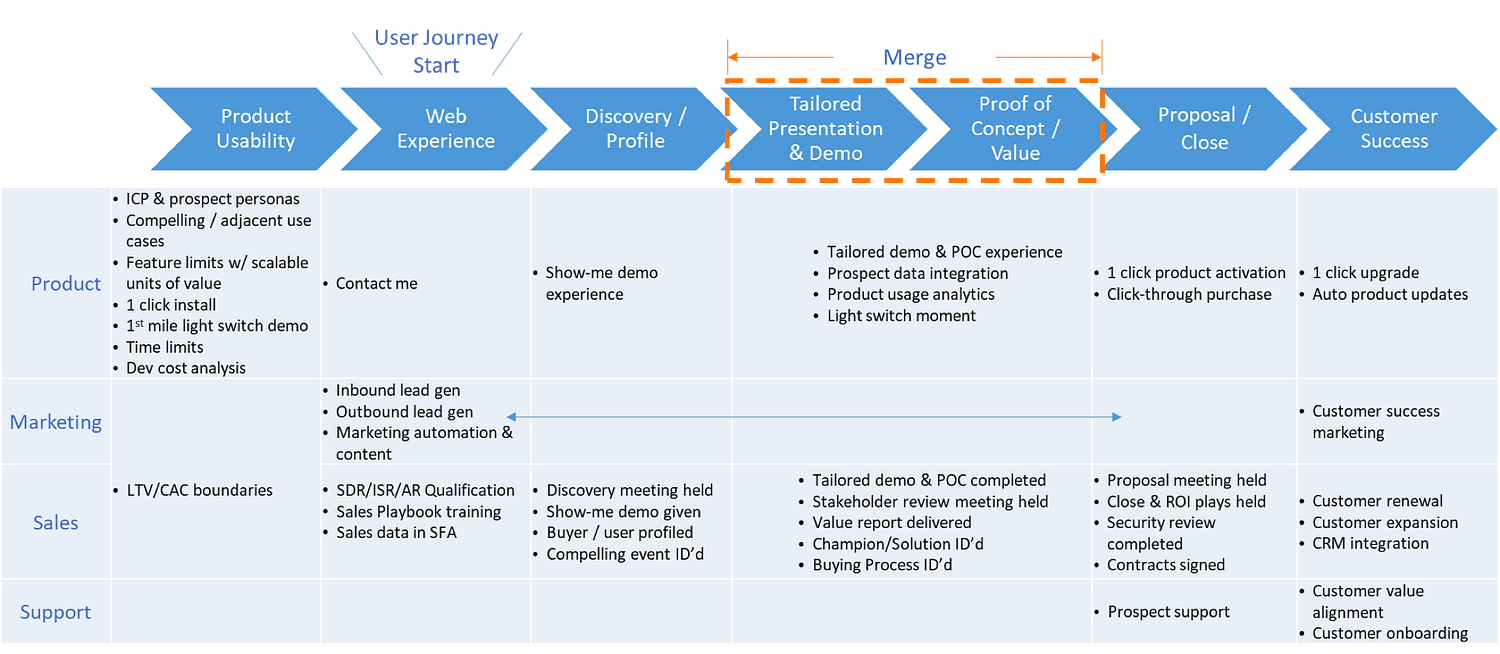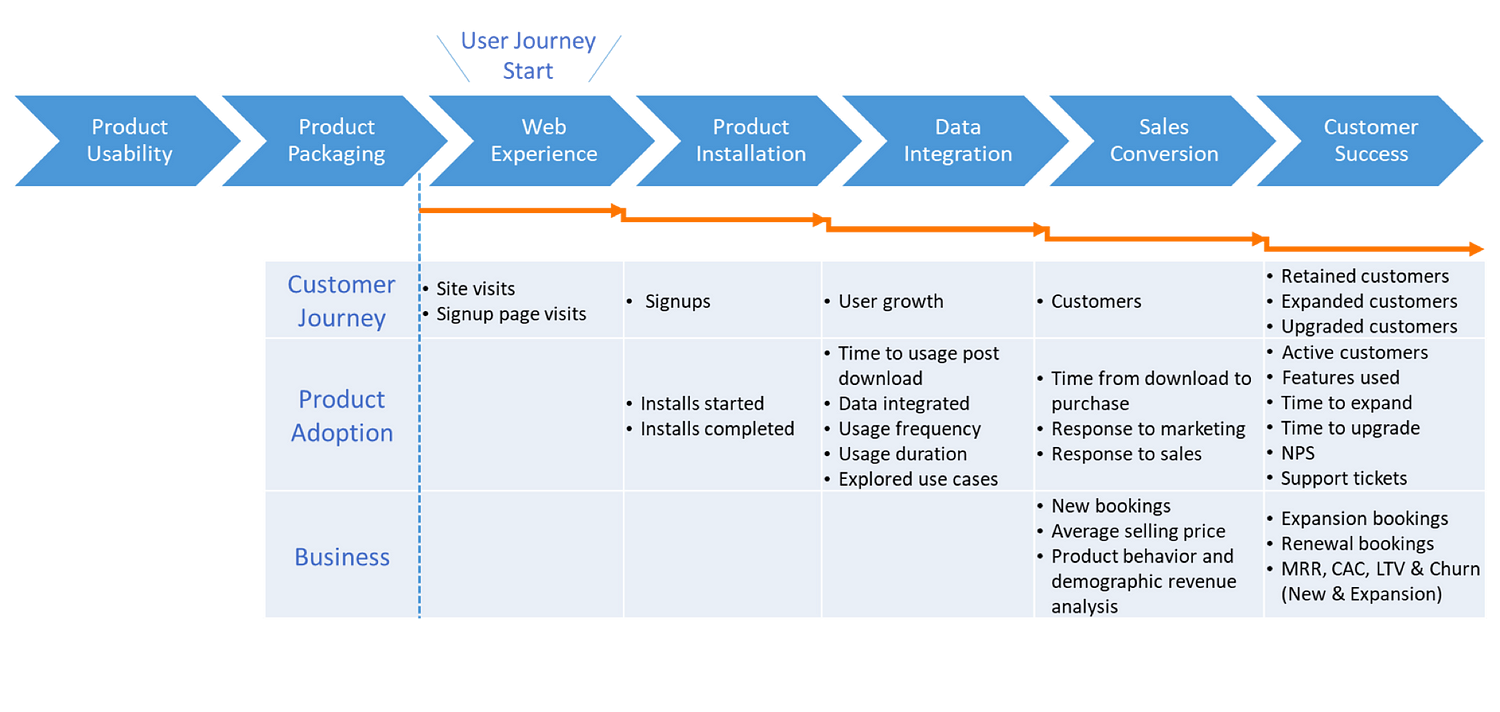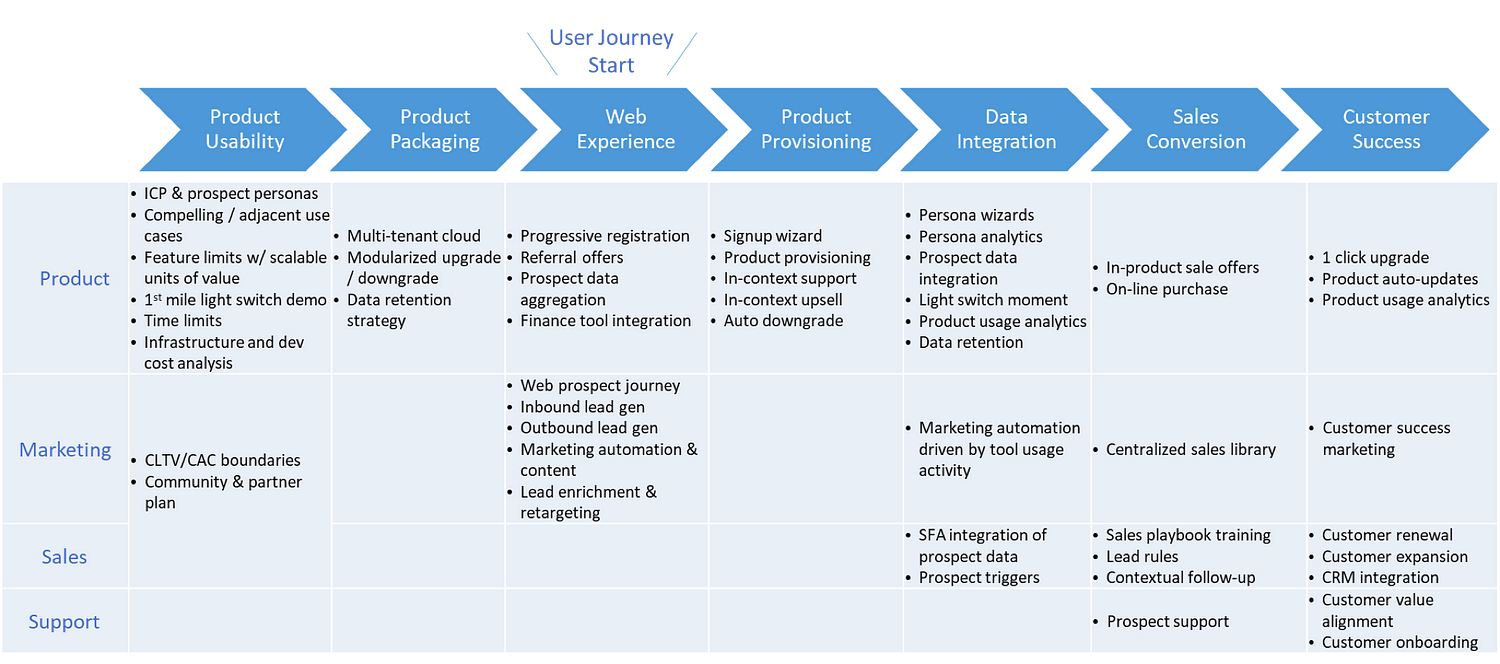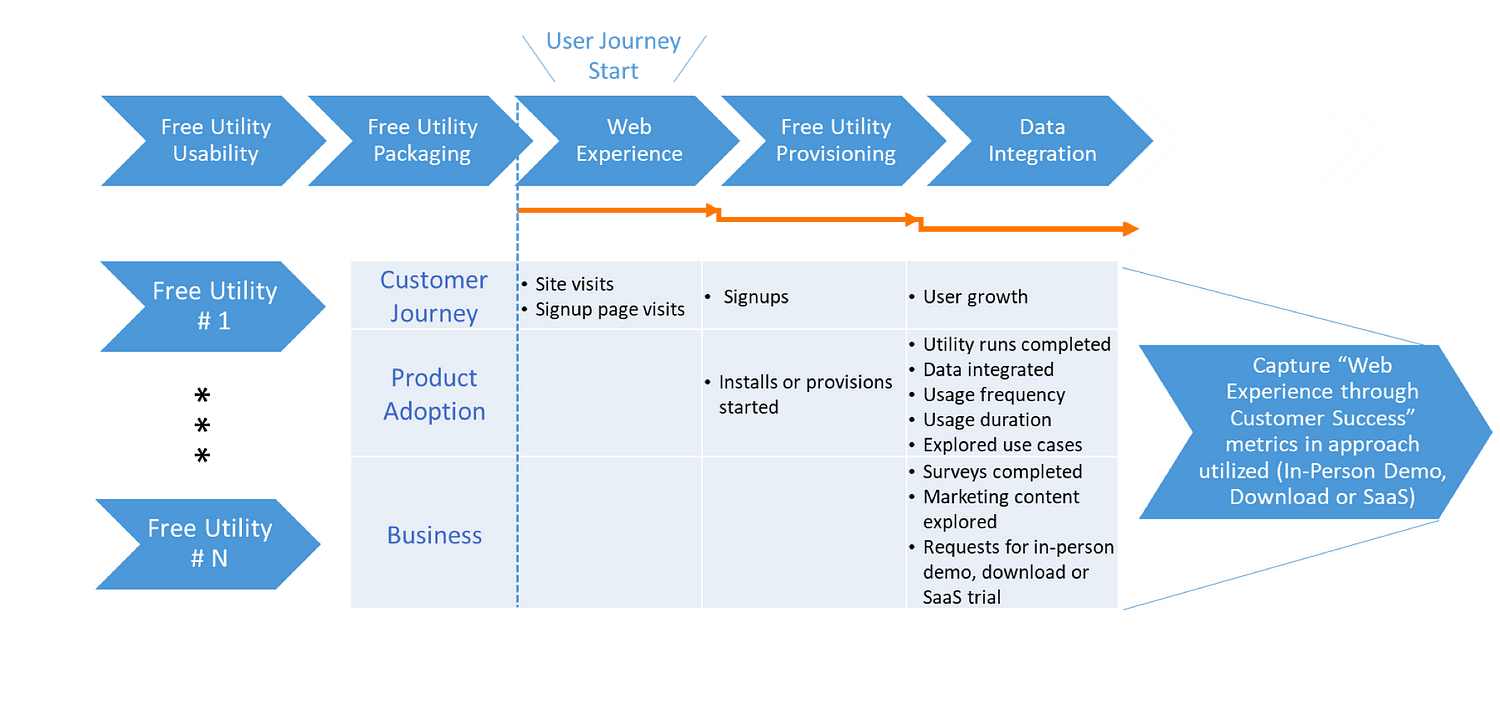The traditional enterprise go-to-market model — lead capture, nurture, sell, install the product, launch the customer, and finally expand usage — forces a prospect into a feature/function analysis and concentrates risk into a single buying decision. In contrast, designing a Sales Ready Product (SRP) approach engages the prospective customer in an iterative learning process. As the focus moves from analyzing capabilities to iteratively testing usability and accelerating time-to-customer value, the buying decision breaks down into a manageable set of lower risk decisions leading to a 6X shortened sales cycle and double the customer close rate.
In Part 1 of this special report, I described this Sales Ready Product go-to-market approach and how it works for almost any software product, market segment and user persona — from SaaS-based sales models focused on individuals or small teams, to seven-figure deal C-level-focused enterprise sales models.
Part 1 also describes:
- Flipping the funnel: How inverting your marketing and sales funnel, and using customer data accelerates sales conversion and customers’ time-to-value
- 4 different SRP go-to-market options: Definitions and examples of In-Person Demos, SaaS, Product Downloads and Free Utilities
- Sales Alignment: How to align your SRP approach with any of the three common B2B sales models — customer self-service, transactional sales and enterprise sales — based on an analysis of your product’s price and complexity
Now, in Part 2, I dive into the detailed nuts and bolts of implementing and measuring a game changing Sales Ready Product approach for each of the 4 customer acquisition options.
The SRP journey
To create a powerful SRP, begin with a highly compelling use case in which the user has a real pain point and an urgency to move. Enable the customer to rapidly integrate their data into your product during the trial. These are sure fire methods to bring the prospect to a “light switch” moment — when the prospect experiences immediate insight into the value of your product.
Implementing a new SRP approach requires changes across your business. Change of any magnitude is best managed as a process, so keep in mind the following best-practice points:
Drive Alignment
Gaining the benefits of a Sales Ready Product strategy requires cross-functional alignment. Integrate company activities and metrics to drive incremental internal improvements at every stage of the prospect and customer journey. At each stage, employ measurable and finely tuned acts of daily customer engagement focused on research-backed personas and value propositions.
Create a Plan
Build a cohesive long-term strategy. All SRP approaches involve cross-functional work and metrics across a series of 7 Stages:
- Product Usability — Build the SRP with emphasis on the compelling use case and first mile usability.
- Product Packaging — Package the product for simple distribution, installation/provisioning, downgrades and easy expansion.
- Web Experience — Optimize your marketing focus and the prospect website journey around the compelling use case from discovery to registration.
- Product Provisioning or Installation — Integrate wizard-driven activation, automated help support, technical marketing content and information for paid-products.
- Data Aggregation/Integration — Create seamless integration of prospect/customer data to your system for rapid demoing and to automatically trigger context and persona specific marketing nurture.
- Sales Conversion — Automatically trigger sales tools and actions based on specific prospect/customer product usage. Automate purchases.
- Customer Success — Automate upgrades and expansions, and trigger your customer success and product enhancement processes.
Be Agile
Don’t do everything at once. To reinforce progress and highlight success, drive towards monthly and quarterly “wins” seeking to gather market, customer, product usage data and inside/outside sales team feedback. Focus on multiple small wins versus one big win and avoid investments in long tail features that only serve a few power users versus features that drive a broader growth base. Measure results and iterate from there.
Prepare for a Culture Shift
Be prepared to change tools, processes and even your culture. The SRP approach is a product-led go-to-market strategy. For instance, this means that your development team is no longer a back-end fulfillment organization reacting to backlog specs handed to them by product management. Instead your development team’s role is to analyze product usage patterns in real time to add features and drive improved customer conversion and satisfaction. Your enterprise sales team requires training on how to uplift customer tool conversations to customer value discussions. Marketing and product management teams need to think like data scientists.
Assign an Executive Owner
An SRP changes your company’s priorities and investment decisions in tools, training and processes. Leadership for this DNA change must come from the top.
Rethink your Metrics
- The SRP expands your available metrics: An SRP approach requires capturing many metrics that span the marketing and sales funnel, customer product usage and adoption, customer success and financial data. Simplify these SRP metrics by summarizing around the customer journey, product adoption and business. Use this data to measure, iterate and improve the prospect’s product usage experiences and to increase the resulting conversion to paid licenses.
- Define your guiding metric: To keep the organization focused on the most relevant direction, consider defining your single most crucial metric to your business. Daily active users? CPU hours utilized? Storage? Bandwidth? Flights booked? Dollars under management? Reduced customer churn? All activities should lead there.
SRP approach details
The following sections outline the cross-functional team efforts and metrics needed for each of the four SRP options — In-Person Demo, Product Download, SaaS and Free Utilities. The comprehensive implementation detail in these sections stems from years of direct experience and lengthy conversations with superior teams and experts in the field.
To maximize the benefits of SRP, experience shows that you need to address most of the bullet points outlined in each approach. However, you will need to modify the bulletized steps in each stage to fit your company’s size and ability to invest. You can make progress by prioritizing your effort on the most significant activities and metrics that guide your team incrementally to the end goal. Keep it simple.
In-Person Demo
The In-Person Demo approach is used to augment your enterprise account management and Challenger sales techniques to accelerate the prospects’ time-to-value. It is characterized by an on-premise sales team interacting with the prospect.
During this in-person demo interaction, it doesn’t matter if the software is installed on the prospect’s system on the sales reps’ laptop, or in your company’s cloud — your product just needs to integrate the prospect’s data as seamlessly as possible. Achieving the desired sales compression benefits requires coordinated activities at each stage of the prospect/customer journey by each of the product development, finance, marketing, sales and support teams, as shown in the table below.
The In-Person Demo approach is very close to the traditional direct sales enterprise approach. It relies on traditional demand generation, marketing content and expert sales processes. As in all four SRP approaches, “flipping” the sales funnel is fundamental. This is accomplished by merging the usually separate “Demo” and “POC” stages (see dashed orange box) as far up in the sales funnel as possible.
Compared to the other SRP approaches, your cost of sales resources, investment in sales playbooks and training using the In-Person Demo approach will be much heavier. The sales and field engineering team is heavily involved at the top of the sales opportunity funnel to educate the prospects, drive interest in your product, and guide their product experience. Traditional product management and customer success activities will be required to gain feedback on your customers’ tool usage patterns and desired feature enhancements. Additional effort will be required in the form of ROI and other proposal documents to educate the client on your product value. The result should be a higher average selling price compared to the other SRP approaches.
Engagement begins when the prospect first visits your web site — the “Web Experience” stage. From there, a fall-off in conversion occurs at each of the subsequent 5 stages of the prospect and customer journey. To improve conversion rates, capture prospect and customer data at each stage. Analyze results continuously to spot ways to improve conversion rates, decrease sales cycle times, and increase perceived customer value at each stage. Pick your most salient Customer Journey, Product Adoption and Business metrics to measure — some examples are shown in the table, below.
Product Download
Software companies sometimes utilize an application Product Download SRP approach. This approach employs a lighter weight open source or proprietary version of the enterprise product to seed and accelerate market penetration to target personas and use cases.
Compared to the In-Person Demo approach where personalized interaction with the prospect is key, the Product Download approach is hands-off by the sales personnel until post-product installation and the moment when purchasing interest is signaled by the prospects’ specific tool usage pattern. This requires a highly integrated and automated approach to all seven stages from product usability through to customer success. See table, below.
Companies using a Product Download approach will often implement a flywheel sales model, leveraging inside sales teams.¹ A distinguishing feature of the flywheel model is that the “outside” enterprise sales team is exclusively “inbound.” They are denied the option of seeking business outside the customer base, and must find business only from existing customers. The enterprise sales team, sometimes part of the Customer Success organization, is an up-sell and cross-sell team.
In practice, most organizations also utilize enterprise sales reps who are free to prospect or follow-up on hot leads. Companies using flywheel models experience more efficient lead generation, customer conversion and expansion than those organizations using an array of demand creation programs because the entire organization is focused on the same thing — building one main customer acquisition mechanism.
Compared to the traditional In-Person Demo approach, the Product Download approach has an advantage in its ability to leverage a call-home facility. This functionality integrates prospect data from the thousands of downloads and prospect activations into the vendors marketing and sales automation tools. A call-home facility therefore enables context sensitive nurture marketing and sales engagement triggered by prospect moments when they are most open to engagement. This increases the measurability of critical conversion points and drives continuous improvement along the prospect to customer journey. Suggested metrics are provided in the table, below.
SaaS
The SaaS SRP approach has several aspects in common with the Product Download SRP. Both options are hands-off by the sales team until post-product provisioning and initial usage triggers purchasing interest. A premium is placed on ensuring a top-notch, customer-driven experience in a SaaS SRP just as in the Product Download SRP. However, the micro-activities differ considerably because control and storage of prospect data sits squarely in the vendor’s SaaS cloud. For instance, server, storage and bandwidth costs should be considered when selecting a “free forever” versus time-based trial strategy.
Light switch moments are easier to achieve with a SaaS approach because live prospect and customer data is continuously stored and processed in the central cloud infrastructure. User behavior patterns and associated events are then used to trigger your marketing and sales automation tools for the purposes of context sensitive marketing and to prompt the sales team to contact prospects when they are most likely to convert.
Homegrown and embedded 3rd party tools such as Pendo, Aptrinsic, Totango and Gainsight are available to guide prospects through certain feature sequences to target and nurture prospect and customer personas. Aptrinsic’s recently published book describes these “product-led go-to-market strategy” automation details and other considerations to deliver personalized SaaS product experiences.² These tools also provide visibility into specific feature usage by existing customers. The result is increased conversion rates, improved customer success, and insight for product management and development to drive feature evolution.
Like the Product Download approach, companies using a SaaS approach will often implement a flywheel sales model for inside sales teams as well as a direct sales approach for larger opportunities. In terms of metrics, see suggestions in the following table.
Free Utilities
The Free Utility SRP approach is used in conjunction with and as an input into any of the other three SRP approaches to create awareness of a vendors’ products while the prospect is still in the needs/solutions discovery phase of their buying cycle. In this approach, release free enterprise software utilities into the market either as a software download or in a publicly available cloud. Target your prospects with elegant utilities that create awareness of the need for your product category and product.
For instance, if you provide application software that helps resolve and manage datacenter network security flaws, then provide free software that can automatically scan an organization’s datacenter network and highlight potential risks in the network.
Your utility may also provide insights and value to the prospects and customers of your business partners. If so, find distribution mechanisms that enable your industry partners to provide your utility to their prospects to drive leads for them, too. This will strengthen your relationship with your business partner, bring even more attention to your company, and increase lead flow for you at the same time.
The Free Utility is essentially a vendor micro-product and must be carefully developed like any other company software. But think of these utilities as electronic marketing and demand creation content. Be nimble and experiment with multiple utilities as you would any other marketing content.
During and after the prospect’s use of the Free Utility, link from the software download or public cloud to your corporate website to showcase how your commercial SaaS and software products can address the prospects needs. Like the Product Download and SaaS SRP approaches, the Free Utility approach can integrate prospect data and events into the vendors marketing and sales automation tools to drive prospect nurturing and trigger sales follow-up.
The stages to achieve sales cycle compression in a Free Utility approach resemble either the Product Download or the SaaS approach, depending upon whether the Free Utility is released as a software download or in a public cloud. However, the specific activities are different because there is a more loosely defined relationship with the prospect. For example, extra work may be required by the vendor to capture social, demographic and firmographic lead enrichment information, as well as to guide the prospect to move into one of the other three SRP flows.
Optimize conversion rates by gathering and analyzing feedback from every prospect interaction with your Free Utility.
Once the prospect clicks through from the Free Utility to your “Web Experience” stage, they migrate into any one of your other SRP approaches — or your traditional sales model, if that’s what you are using. There will then be a fall-off in conversion at each of the subsequent stages of the prospect and customer journey. As with the other SRP approaches, data should be captured continuously and analyzed to drive precision conversion improvements. The table below provides some suggested metrics for each stage.
At a Glance
For your reference, please see a comparison chart of the 4 different SRP approaches, below. Low/Med/High refer to the relative difference of each of the 4 SRP approaches for each row, not to an absolute level of effort or quality.
Final Thoughts
At last count, there were 5000+ industry sales and marketing automation tools — there will be more. Apart from a few exceptions, I did not attempt to map commercial 3rd party automation tools to the detailed steps provided in each SRP approach. The individual tools are less important than enacting a smart, measurable process in which you:
- Invert your sales funnel: Lead with your product. Build a Sales Ready Product, not a Minimum Viable Product. Then smartly rollup users and teams into larger transactions using “one-click” product conversion and finely tuned sales processes.
- Focus on your customer: Build a demo/trial with a highly compelling use case that addresses a real pain point.
- Use customer data: Automatically integrate prospect and customer data into your product to drive customer “light switch” conversion moments.
- Align companywide: Drive revenue-centric product development focused on conversion moments.
Accomplished successfully, a product-first strategy that accelerates your customers’ time-to-value accelerates your revenues, too. It also contributes to an enjoyable companywide culture focused on the customer experience with your product.
I trust you have found the information in this 2-part special report helpful. The techniques outlined here continue to evolve based on the work I perform with tech-company CEOs as Partner and Managing Director at CEO Quest. Your feedback is always welcome and appreciated. And of course, please reach out to me if you’d like any further perspective.
. . .
Notes:
- Tomasz Tunguz. “The Innovator’s Solution For SaaS Startups — The Flywheel SaaS Company.” Blog post. tomtunguz.com. April 19, 2015.
- Nick Bonfiglio, Mickey Alon, Myk Pono. “Mastering Product Experience in SaaS — How to Deliver Personalized Product Experiences with Product Led Go-to-Market Strategy.” E-book. intrinsicpoint.com. October 3, 2017.











